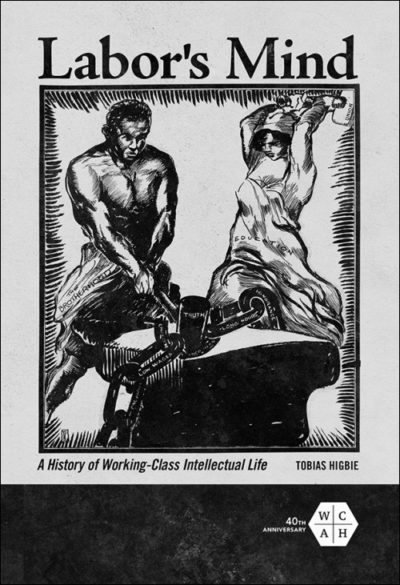The Book
Labor's Mind: A History of Working-Class Intellectual Life
The Author(s)
Tobias Higbie

This week we will be running a roundtable on Toby Higbie’s Labor’s Mind: A History of Working-Class Intellectual Life.
Labor’s Mind was published in January of this year by University of Illinois Press in its prestigious series, “The Working Class in American History.” Now edited by James R. Barrett, Julie Greene, William P. Jones, Alice Kessler-Harris, and Nelson Lichtenstein, when it began in the 1970s the editors were Herbert Gutman, David Brody, and David Montgomery.
The series includes a number of authors and works known to all stripes of American historians and the S-USIH community. A sampling of its titles includes: Mari Jo Buhle’s Women and American Socialism, 1870-1920; Nick Salvatore’s Eugene V. Debs: Citizen and Socialist; James R. Barrett’s Work and Community in the Jungle; Susan Porter Benson’s Counter Cultures; and The Pew and the Picket Line (eds. Christopher D. Cantwell, Heath W. Carter, and Janine Giordano Drake).
Labor’s Mind consists of an Introduction, five chapters, and a brief Conclusion. The book clocks in at a very readable 152 pages. Part one, “Reading the Marks of Capital,” consists of three chapters. The first covers the social world of readers; chapter two meditates on open forums and the public sphere for working-class thinkers; chapter three speaks to institutions and labor colleges.
Part two, “Imagining Critical Consciousness,” contains two chapters (4-5). Chapter four focuses on the life stories of workers and the politics of experience (e.g. how to make a rebel). Then chapter five dives into visual culture, covering cartoons as well as magazine and newspaper images. The iconography selected by Higbie covers both working-class ignorance, self-education, and enlightenment. The Conclusion dives into the Cold War and a bit beyond. It begins with an interesting analysis of Eric Hoffer, the so-called “longshoreman philosopher.”
Tomorrow’s review is from Peter Cole. Cole is a professor of history at Western Illinois University and Research Associate in the Society, Work and Development Institute at the University of the Witwatersrand in Johannesburg, South Africa. Cole is the author of the award-winning Dockworker Power: Race and Activism in Durban and the San Francisco Bay Area* and Wobblies on the Waterfront: Interracial Unionism in Progressive-Era Philadelphia*. He co-edited Wobblies of the World: A Global History of the IWW and edited Ben Fletcher: The Life & Times of a Black Wobbly. He also is the founder and co-director of the Chicago Race Riot of 1919 Commemoration Project. [*Both are also in same Illinois Press series.]
Wednesday’s contribution is from Janine Giordano Drake. Drake is Assistant Clinical Professor of History in the Indiana University History Department, where she specializes in US labor, social and religious history. She has authored a number of articles and chapters on race, class, and gender in the Social Gospel movement and the Religious Left. She co-edited Between the Pew and the Picket Line (University of Illinois Press, 2015) and is (still) completing her manuscript “War for the Soul of the Christian Nation: The Socialist Movement and the Protestant Churches, 1880-1920.” At Indiana University, in addition to teaching undergraduate and graduate courses, Janine works with the Advance College Project as a public historian. In this capacity, she helps prepare Indiana high school students for college by training and resourcing Social Studies teachers to lead college-level history courses.
Thursday’s essay is from Leilah Danielson. Danielson teaches recent American history and US/World at Northern Arizona University. She has published a number of articles on the history of the peace movement and the role of religion and race in American political culture. She is the author of the book American Gandhi: A.J. Muste and the History of American Radicalism in the Twentieth Century (University of Pennsylvania Press, 2014) and co-editor (with Doug Rossinow and Marian Mollin) of The Religious Left in Modern America: Doorkeepers of a Radical Faith (Palgrave Macmillan, 2018), which is coming out in paperback this spring.
On Friday we will see Higbie’s response.
Happy reading! Comment as the reviews appear. All participants, including this convener, will likely engage. – TL

One Thought on this Post
S-USIH Comment Policy
We ask that those who participate in the discussions generated in the Comments section do so with the same decorum as they would in any other academic setting or context. Since the USIH bloggers write under our real names, we would prefer that our commenters also identify themselves by their real name. As our primary goal is to stimulate and engage in fruitful and productive discussion, ad hominem attacks (personal or professional), unnecessary insults, and/or mean-spiritedness have no place in the USIH Blog’s Comments section. Therefore, we reserve the right to remove any comments that contain any of the above and/or are not intended to further the discussion of the topic of the post. We welcome suggestions for corrections to any of our posts. As the official blog of the Society of US Intellectual History, we hope to foster a diverse community of scholars and readers who engage with one another in discussions of US intellectual history, broadly understood.
Very happy to see that this wonderful book is getting the attention it deserves from intellectual historians. It turns out that workers read and thought…. Taken seriously, the work can help to change our understanding of intellectual history.